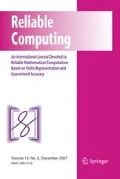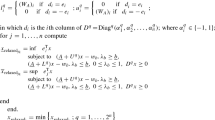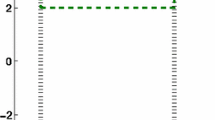Abstract
This paper tackles the combination of interval methods for solving nonlinear systems. A cooperative strategy of application of elementary solvers is designed in order to accelerate the whole computation while weakening the local domain contractions. It is implemented in a prototype solver which efficiently combines interval-based local consistencies and the multidimensional interval Newton method. A set of experiments shows a gain of one order of magnitude on average with respect to Numerica.
Similar content being viewed by others
References
Apt, K. R.: The Essence of Constraint Propagation, Theoret. Comput. Sci. 221(1-2) (1999), pp. 179-210.
Benhamou, F.: Heterogeneous Constraint Solving, in: Proc. Int. Conference on Algebraic and Logic Programming, 1996.
Benhamou, F., Goualard, F., Granvilliers, L., and Puget, J.-F.: Revising Hull and Box Consistency, in: Proc. Int. Conference on Logic Programming, 1999.
Benhamou, F. and Granvilliers, L.: Automatic Generation of Numerical Redundancies for Nonlinear Constraint Solving, Reliable Computing 3(3) (1997), pp. 335-344.
Benhamou, F., McAllester, D., and Van Hentenryck, P.: CLP(Intervals) Revisited, in: Proc. Int. Logic Programming Symposium, 1994.
Benhamou, F. and Older, W. J.: Applying Interval Arithmetic to Real, Integer and Boolean Constraints, J. Logic Programming 32(1) (1997), pp. 1-24.
Berz, M. and Hoffstätter, G.: Computation and Application of Taylor Polynomials with Interval Remainder Bounds, Reliable Computing 4(1) (1998), pp. 83-97.
Cleary, J. G.: Logical Arithmetic, Future Comp. Sys. 2(2) (1987), pp. 125-149.
Collavizza, H., Delobel, F., and Rueher, M.: Comparing Partial Consistencies, Reliable Computing 5(3) (1999), pp. 213-228.
Farouki, R. and Rajan, V.: On the Numerical Condition of Polynomials in Bernstein Form, Comput. Aided Geom. Design 4(1987), pp. 191-216.
Garloff, J. and Graf, B.: Symbolic Methods in Control SystemAnalysis and Design, in:Munro, N. (ed.), Solving Strict Polynomial Inequalities by Bernstein Expansion, IEE London, 1999, pp. 339-352.
Granvilliers, L.: A Symbolic-Numeric Branch-and-Prune Algorithm for Solving Nonlinear Polynomial Systems, J. Universal Computer Science 4(2) (1998), pp. 125-146.
Granvilliers, L. and Benhamou, F.: Progress in the Solving of a Circuit Design Problem, J. Global Optim., accepted.
Granvilliers, L., Goualard, F., and Benhamou, F.:Box Consistency through Weak Box Consistency, in: Proc. IEEE Int. Conference on Tools with Artificial Intelligence, 1999.
Hansen, E. R.: Global Optimization Using Interval Analysis, Marcel Dekker, 1992.
Henkin, L., Monk, J. D., and Tarski, A.:Cylindric Algebras, Studies in Logic, North-Holland Publishing Company, Amsterdam-London, 1971.
IEEE Standard for Binary Floating-Point Arithmetic, Institute of Electrical and Electronics Engineers, IEEE Std 754-1985, 1985, reaffirmed 1990.
Kahan, W. M.: A More Complete Interval Arithmetic, in: Lecture Notes for an Engineering Summer Course in Numerical Analysis, University of Michigan, 1968.
Kearfott, R. B.: Some Tests of Generalized Bisection, ACMTrans. Math. Software 13(3) (1987), pp. 197-220.
Kearfott, R. B. and Shi, X.: Optimal Preconditionners for Interval Gauss-Seidel Methods, in: Scientific Computing and Validated Numerics, 1996, pp. 173-178.
Lhomme, O.: Consistency Techniques for Numeric CSPs, in: Proc. Int. Joint Conference on Artificial Intelligence, 1993.
Lhomme, O., Gotlieb, A., and Rueher, M.: Dynamic Optimization of Interval Narrowing Algorithms, J. Logic Programming 37(1-2) (1998), pp. 165-183.
Moore, R. E.: Interval Analysis, Prentice-Hall, Englewood Cliffs, NJ, 1966.
Neumaier, A.: Interval Methods for Systems of Equations, Cambridge University Press, Cambridge, 1990.
Puget, J.-F. and Leconte, M.: Beyond the Glass Box: Constraints as Objects, in: Proc. Int. Logic Programming Symposium, 1995.
Ratschek, H. and Rokne, J.: About the Centered Form, SIAM J. Numer. Anal. 17(3) (1980), pp. 333-337.
Stahl, V.: Interval Methods for Bounding the Range of Polynomials and Solving Systems of Nonlinear Equations, PhD thesis, University of Linz, Austria, 1995.
Van Hentenryck, P., McAllester, D., and Kapur, D.: Solving Polynomial Systems Using a Branch and Prune Approach, SIAM J. Numer. Anal. 34(2) (1997), pp. 797-827.
Van Hentenryck, P., Michel, L., and Deville, Y.: Numerica: a Modeling Language for Global Optimization, MIT Press, 1997.
Verschelde, J.: Database of Polynomial Systems, Michigan State University, USA, 1999, http://www.math.msu.edu/jan/demo.html.
Verschelde, J.: PHCpack: A General-Purpose Solver for Polynomial Systems by Homotopy Continuation, ACM Trans. Math. Software 25(2) (1999), pp. 251-276.
Author information
Authors and Affiliations
Rights and permissions
About this article
Cite this article
Granvilliers, L. On the Combination of Interval Constraint Solvers. Reliable Computing 7, 467–483 (2001). https://doi.org/10.1023/A:1014750702474
Issue Date:
DOI: https://doi.org/10.1023/A:1014750702474




